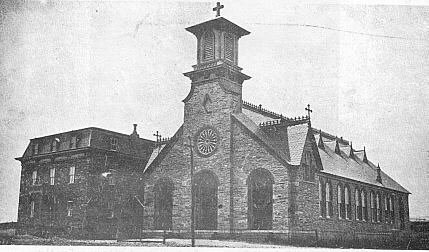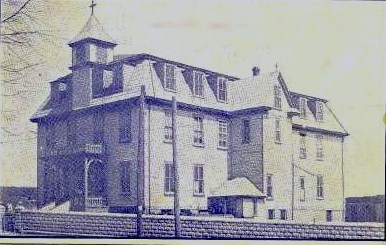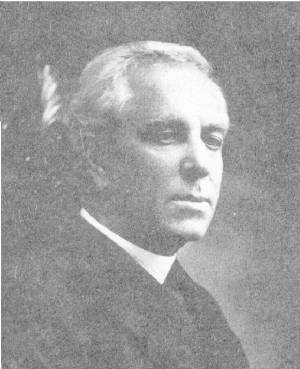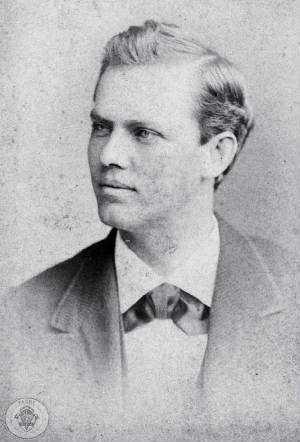
|

|

|
| St. Ignatius Church and Rectory in earlier years |
Enter secondary content here

St Ignatius School

|
| REV. DANIEL IGNATIUS McDERMOTT First pastor -1869---1872 |

|
| INTERIOR OF ST. IGNATIUS CHURCH |



Clickable links
SEE ALSO PAGE 2
See also page 3
Return to first index page
MEMORIES OF ST. IGNATIUS
Saint Patrick's Day Minstrel
Friday night bingo
Saturday confession
May processions
Clapping erasers
Fasting for lent
OK, Now let's hear some of yours--
E-mail them
to me at mpreil @aol.com
Mike Reilley
|

|

|

|

|

|
|
|
|
|
|
|
|
|
|
|
|
|
|
|
|
|
|
|
|
|
|
|
|
|
|
|
|
|
|
|
|
|
|
|
|
|
|
|
|
|
MOST OF THE INFORMATION ABOUT
THE HISTORY OF THE CHURCH CAME FROM THE PARISH CENTENNIAL BOOK
PUBLISHED IN 1969.
Saint Ignatius Church is another victim of the
underground mine fire that burns beneath
the town of Centralia, Pa.. Because of the fire this small town in central Pennsylvania is almost deserted. Most people have moved away, stores, the bank, churches and post office have all closed and relocated elsewhere. This
is the story of St Ignatius Church.
Catholics were among the earliest residents of Centralia,
coming into the area as early as 1855 when
the Locust Mountain Coal and Iron Company began erecting houses for its employees. At that time they were mostly all Irish immigrants who came to this country to escape famine and bad times in their native country.
Later in the nineteenth century and
early in this century, Catholics from the eastern and southern European countries come for similar reasons.
Father Michael
Sheridan, who was pastor of St. Joseph's Parish in Ashland, provided for the Catholics of Centralia as part of his parish from the time that parish was organized in 1856 until 1868. In 1868 Centralia came within
the boundaries of the newly formed Diocese
of Harrisburg. Because of the fact that Centralia was no longer located within the Archdiocese of Philadelphia, and because of the increasing number of Catholics here, it was decided
to establish a separate parish. Bishop Jeremiah
F.Shanahan the first Bishop of the Dicocese of Harrisburg, then appointed the Rev.Daniel Ignatius McDermott to set about the task of organizing a parish.
Father McDermott
was only twenty five years old when he began his work in Centralia and had been ordained a priest only ten months before this assignment. For a brief period Father McDermott celebrated Mass at St. Joseph's Church,
Ashland which was attended by the Catholic
people from Centralia. Then on April 12,
1869 he come to Centralia and celebrated two Masses the following Sunday in the school house on East Main Street. Later he celebrated Mass in another school house on East Railroad Street until the church was built.
|
|
|
|
|
|
|
|
|
|
|
|
|
|
|
|
|
|
|
|
|
|
|
|
|
|
|
|
|
|
|
|
|
|
|
|
|
|
|
|
|
|
|
|
|
|
|
|
|
|
|
|
|
|
|
In the meantime
he lived in a house at 108 West Railroad Street and said weekday Masses there and these Masses were served by B. I. Curran and Thomas O'Connor, the original altar boys. The parishioners under the direction of Father McDermott then began the task of building a church. It was
at first planned to build the church on
the vacant lot on East Centre Street but it was then decided to build elsewhere because future mining operations were planned for under that section. The Locust Mountain Coal and Iron Company then donated four lots on South
Locust Avenue at the top of the hill where
the. company said a solid conglomerate rock
base exists. It was decided that the church be built there and the cornerstone was laid by Bishop Shanahan on July 18, 1869. The structure was completed and dedicated on November 18, 1869 by Bishop Shanahan. The church was constructed
of native rock gathered from the mountain
and had been in continuous use since its erection.
It was the oldest Catholic church edifice to be found anywhere in this area and its excellent condition was a tribute to the foresight of those in charge of planning and erection. Father McDermott had the cemetery
started in 1869 and the first burial was
that of Patrick Flanigan who was killed near Locust Dale. Saint Ignatius was the first parish established in what is now the Mount Carmel Deanery. In 1869 Father Mc Dermott decided to build a mission church
at Mount Carmel. Previous to this the Catholics
there were attending Mass held on certain occasions in a school house, by Father Koch of Shamokin. The mission was built and was taken care of by Father McDermott and his successor, Father Field until 1878 when it was made a separate parish with Rev. J. J. O'Reilly
as first pastor. Between 1870-78 the priests
of St. Ignatius also said Mass in St. Joseph's Church, Locust Gap, along with the priests from Shamokin, until a resident pastor was appointed there. Father McDermott built the parish membership from 348 souls to over
1500 in one year's time. In 1870 he had
the rectory built beside the church. It was also built
of stone. Father McDermott remained as pastor until February of 1872 when he was recalled by the Archbishop of Philadelphia and assigned to New Philadelphia. The Rev. Edward T. Field who was assistant pastor then
took over as pastor. Both Father McDermott
and Father Field were well known throughout the region
for the stand they took against the disorders which were prevalent at that time. Father Field was pastor until he become ill and had to be taken to a hospital in Philadelphia
Rev. James J. Russell
was appointed third pastor to succeed Father Field, who died on June 12, 1884. During his pastorate the baptismal font was installed in the church, and the wooden columns supporting the roof were replaced with
iron ones. At a meeting of the parishioners
it was also decided to build a two story brick addition
to the back of the rectory. This was undertaken and was financed by each adult contributor of the parish being assessed the sum of twelve dollars. This campaign for funds began in July of 1884 and all assessments were to
be paid up by 1887. In the latter year another
meeting was held at which time it was decided to take
action "legal or otherwise" against those who failed to meet their assessments. When these improvements to the church and rectory were completed the parish debt stood at $2,200. Father Russell remained as pastor of
St. lgnatius until April 20, 1888 when he
was transferred to Columbia. After Father Russell was transferred, the Rev. Thomas F. Kennedy become the fourth pastor. The interior of the church was redecorated during his pastorate and was
decorated with paintings on the ceilings
and walls. Father Kennedy held the office as pastor until 1891 when he was succeeded by the Rev. Michael C Power. Father Power took a keen interest in the parish and built up the membership to over 3000
souls. He died in May of 1895 and was succeeded
by the Rev.Charles J. Kenney who was his
assistant pastor. Scarcely a year later Father Kenney died. Both Father Kenney and Father Power were buried in a lot adjacent to the church building. When the convent was built it then became necessary to remove their
bodies and bury them in the
priest lot in the cemetery. | |

|
| Rev. Edward T Field |
|
Rev. Edward T. Field |
|
|
|
Born 2-5-1841 in Phila. PA
Admission to St. Charles Borromeo
Seminary in Phila, PA on 9-1-1865.
Ordained 1-2-1869 (The same
day as John W. Shanahan later Bishop
of Harrisburg) by Bishop J.F. Shanahan
in the Cathedral of SS. Peter &
Paul in Philadelphia PA. According
to the Catholic Standard 1-9-1869 he
sang Vespers on the afternoon of Jan.
3rd at St. Michael's at 2nd & Masters
Sts. in Phila. He intended to
say his first Mass on Epiphany at St.
Peter's in Wilmington DE.
1870: First post at Corpus
Christi in Chambersburg, Franklin Co.
PA
1872: Our Lady of Mr. Carmel
in Mt. Carmel, PA
1874: St. Ignatius; Centralia,
PA
1884: Died in Baltimore on
June 12
Information by:
Philadelphia Archdiocesan Historical Research Center
|
|

|

|

|

|

|
|

|

|

